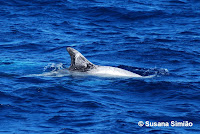9am
This morning we went to the south of Pico for a surprising whale watching trip. The weather was a bit rough, but we encountered some sperm whales (Physeter macrocephalus). First, we encountered a male sperm whale, but he was shortly followed by four females (or juvenile males). One of these individuals breached five time in a roll. That means it jumped out of the water completely, making it possible to see the entire body of the animal. More individuals showed up and they were clearly socializing because at one point there were nine animals at the surface together. Besides the breacher there were animals tail slapping as well. That means their tails were coming out of the water at they would slap them against the surface of the water. Tail slapping and breaching are usual socializing behaviours for the sperm whales.
Despite the rough weather, the vigia Antero was also seeing some dolphins so we headed towards where he was seeing them. They were striped dolphins (Stenella coeruleoalba). The group was avoiding the boat, as is typical of these animals so we did not stay long with them. Given that, plus the weather conditions I'm actually quite impressed at the picture I was able to take, in which is clearly visible the black stripe these dolphins have in their flanks going from their eyes to the rear part of the body, that explains the designation of striped dolphins as their common names.
09.00
Esta manhã fomos até ao sul do Pico para uma viagem de observação de cetáceos surpreendente. O tempo estava um pouco mau, mas encontrámos alguns cachalotes (Physeter macrocephalus). Primeiro, encontrámos um cachalote macho, mas a ele juntaram-se quatro fêmeas (ou machos juvenis). Um destes cachalotes saiu totalmente fora de água cinco vezes seguidas, tornando possível o avistamento do corpo todo do animal. Apareceram mais indíviduos e claramente estavam a socializar porque a um certo ponto estavam nove indivíduos juntos à superfície. Além do indivíduo que saltou, havia outro que estava a bater com a cauda. Isso significa que a cauda saía totalmente fora da água e eles batiam com a cauda na superfície da água com força. Bater com a cauda e saltar fora de água são exibições comportamentais usuais dos cachalotes quando socializam.
Apesar do mau tempo, o vigia Antero também avistou golfinhos por isso fomos até ao local onde ele os avistou. Eram golfinhos riscados (Stenella coeruleoalba). Os golfinhos estavam a evitar a embarcação, como é típico destes animais por isso não permanecemos muito tempo com estes animais. Dado o seu comportamento, somado ao facto das condições climatéricas não serem as melhores, estou bastante impressionada com uma das fotografias que consegui tirar em que se vê claramente a risca preta que estes golfinhos têm no flanco desde os olhos até à parte de trás do corpo, que explica a designação do seu nome vulgar de golfinhos riscados.
Susana Simião

(breaching sperm whale, what we see in the picture is the belly of the animal, the white part on the left is its mouth/cachalote a saltar totalmente fora de água, o que vemos na fotografia é o ventre do animal, a parte branca do lado esquerdo é a boca)

(striped dolphins where we can clearly see the black stripe that gives name to these individuals/golfinhos riscados onde podemos ver a risca preta que explica o nome destes indivíduos)





.jpg)


.jpg)









































